| IC 1318 This is an image of part of the diffuse emission nebula that surrounds the star Gamma Cygni (Sadr). Sadr is the bright glow just to the upper left of the image. This nebula also contains a number of dark nebulae as well. |
IC 1318 - Black
and White This is a black and white version of the image to the left. Sometimes processing an image this way will show more contrast and thus more detail. Adding some star diffraction spikes may also give the image a little more visual appeal. |
Messier 1 - The
Crab Nebula The Crab Nebula was first identified by John Bevis in 1731. It is a supernova remnant that was first observed by Chinese astronomers in 1054. It is about 6500 light years away and spans a diameter of about 11 light years. The star that went supernova is now known as the Crab Pulsar, a pulsar that spins 30 times per second. |
|
Location: Bonny Doon Airport, CA Date: November 10, 2012 Mount: AP 900GTO Telescope: Orion 190mm f/5.3 Mak/Newt Camera: SBIG ST-4000xcm OSC @ -28c Exposure: 18 x10 min. subs = 3hrs. |
Location: Bonny Doon Airport, CA Date: November 10, 2012 Mount: AP 900GTO Telescope: Orion 190mm f/5.3 Mak/Newt Camera: SBIG ST-4000xcm OSC @ -28c Exposure: 18 x 10 min. subs = 3hrs. |
Location: Lake San Antonio, CA Date: February 3, 2011 Mount: Losmandy G11 Go-To Telescope: Meade 10" f/10 SCT Camera: SBIG ST-4000xcm OSC @ -26c Exposure: 3 x20 min. subs = 1hr. |
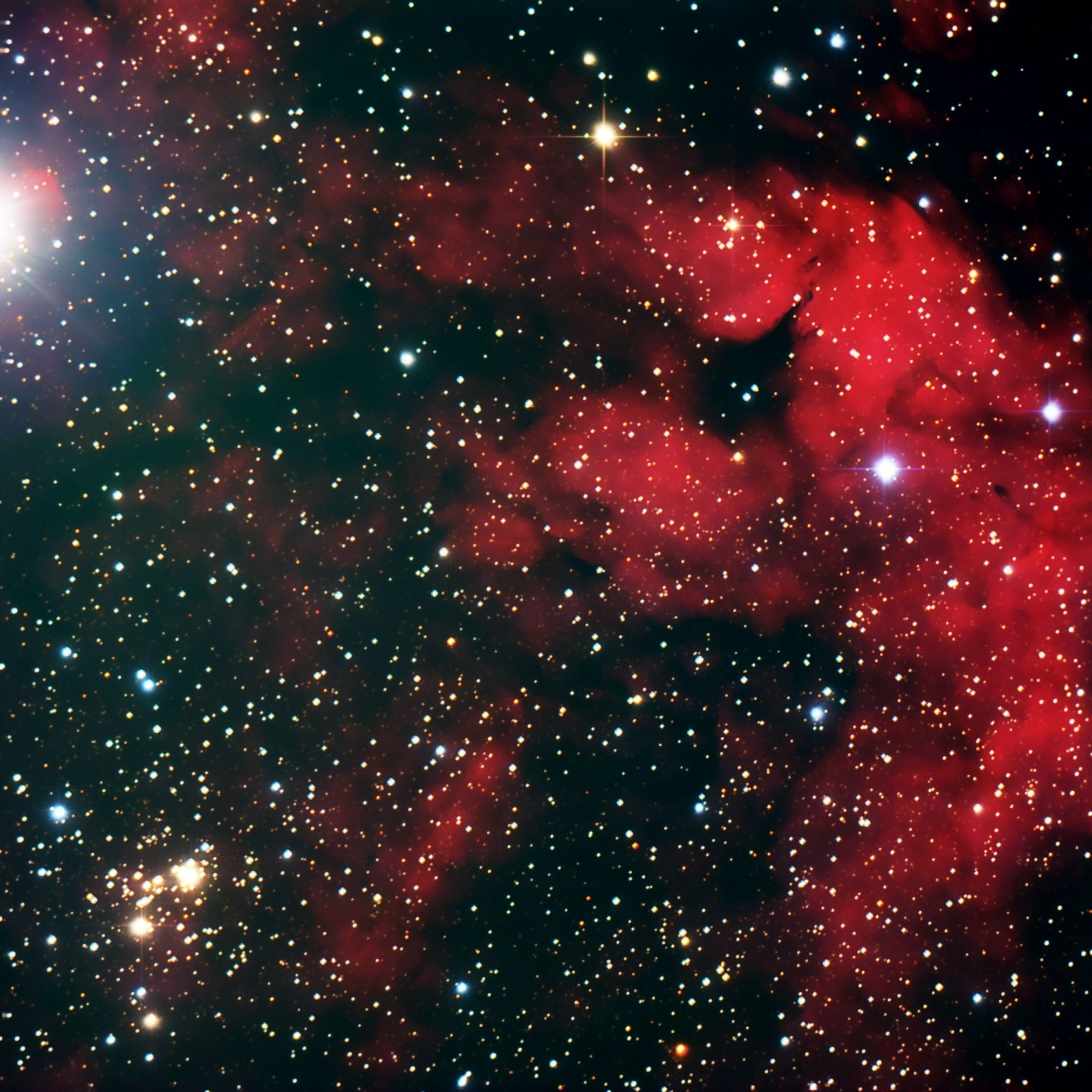 |
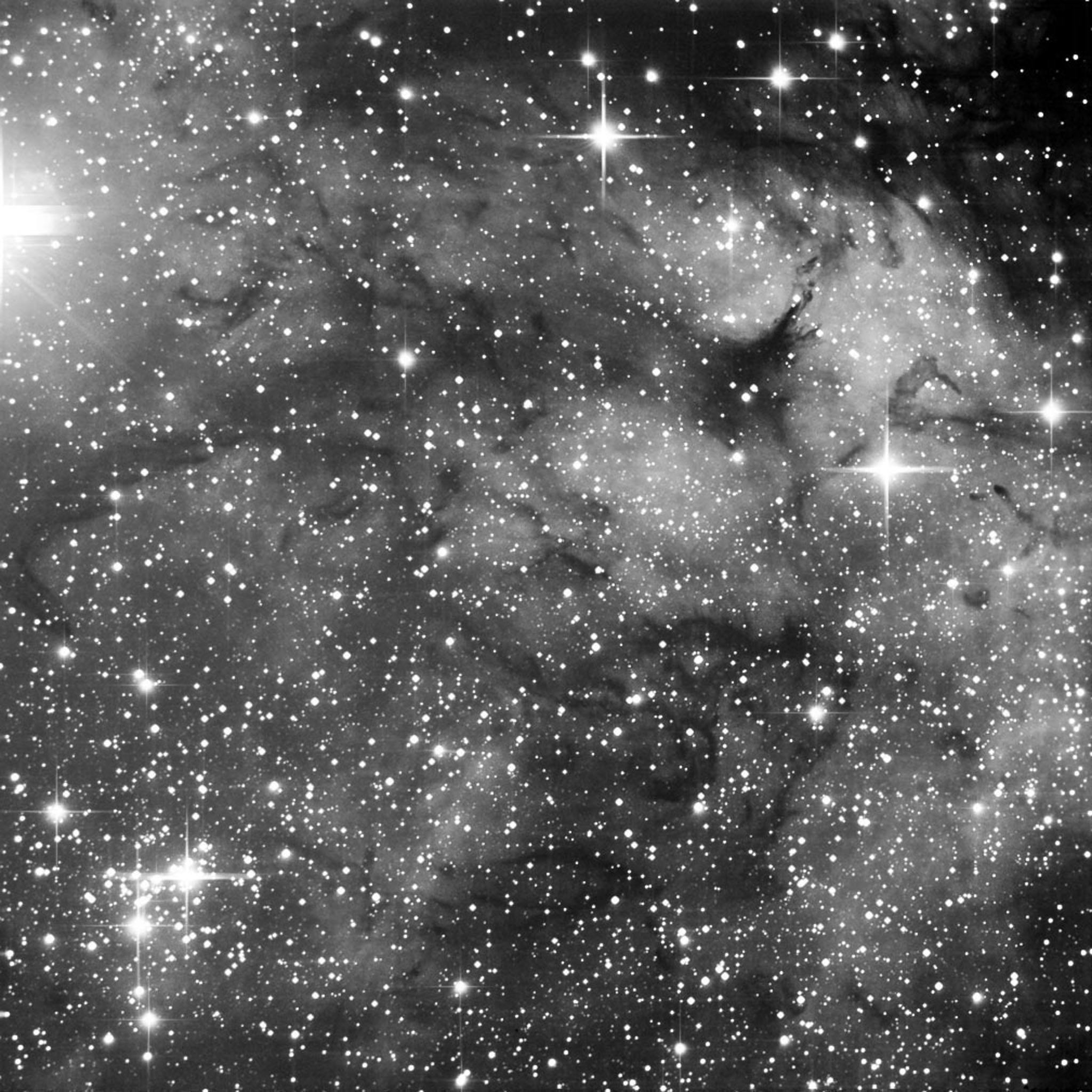 |
 |
| IC 1805 - The
Heart Nebula The Heart Nebula is an emission nebula consisting of dark dust lanes and glowing gas. It is about 7800 light years away. |
IC 1805 - The
Heart Nebula - Black and White This is a black and white version of the image to the left. |
Messier 8 - The
Lagoon Nebula The Lagoon Nebula is an immense cloud of interstellar gas and is an emission nebula. It lies about 6500 light years away and spans 110 by 50 light years. |
|
Location: Borrego Springs, CA Date: October 28, 2011 Mount: Losmandy G11 Go-To Telescope: Orion 190mm f/5.3 Mak/Newt Camera: SBIG ST-4000xcm OSC @ -14c Exposure: 10 x 10 min. subs = 1hr. 40min. |
Location: Borrego Springs, CA Date: October 28, 2011 Mount: Losmandy G11 Go-To Telescope: Orion 190mm f/5.3 Mak/newt Camera: SBIG ST-4000xcm OSC @ -14c Exposure: 10 x 10 min. subs = 1hr. 40min. |
Location: Cabrillo College Observatory, CA Date: September 24, 2008 Mount: Losmandy GM-8 Telescope: Meade LDX-75 8" f/4 Camera: SBIG ST-4000 OSC @ -23c Exposure: 3 x 5 min. subs = 15min. |
 |
 |
 |
| Messier 45 - The
Pleiades Messier 45, sometimes known also as The Seven Sisters, is an open cluster. It's made up of a number of very hot blue stars that formed within the last 100 million years. The cluster is moving through an interstellar dust cloud and illuminating the dust which makes the dust cloud a reflection nebula. |
Messier 57 - The
Ring Nebula The Ring Nebula is a planetary nebula that lies 4100 light years away and is between 6000 and 8000 years old. As an average size star nears the end of its life it expands to a very large diameter. As the last of its fuel is expended it explosively sheds its outer atmosphere and then contracts to leave an expanding planetary nebula and a white dwarf star at its center. The ring is more than 1000 times the width of our own solar system (Sun to Neptune distance). |
Messier 57 - The
Ring Nebula This is a cropped and zoomed version of the image of M57 to the left. Right near the center of the image you can see the very small and very faint spiral galaxy IC 1296. |
|
Location: Bonny Doon Airport, CA Date: October 23, 2011 Mount: Losmandy G11 Go-To Telescope: Orion 190mm f/5.3 Mak/Newt Camera: SBIG ST-4000xcm @ -14 Exposure: 6 x 10 min. subs = 1hr. |
Location: Cabrillo College Observatory, CA Date: November 22, 2008 Mount: Losmandy GM-8 Telescope: Meade LDX-75 8" f/4 Camera: SBIG ST-4000xcm OSC @ -23c Exposure:6 x10 min. subs = 1hr. |
Location: Cabrillo College Observatory, CA Date: November 22, 2008 Mount: Losmandy GM-8 Telescope: Meade LDX-75 8" f/4 Camera: SBIG ST-4000xcm OSC @ -23c Exposure:6 x 10 min. subs = 1hr. |
 |
 |
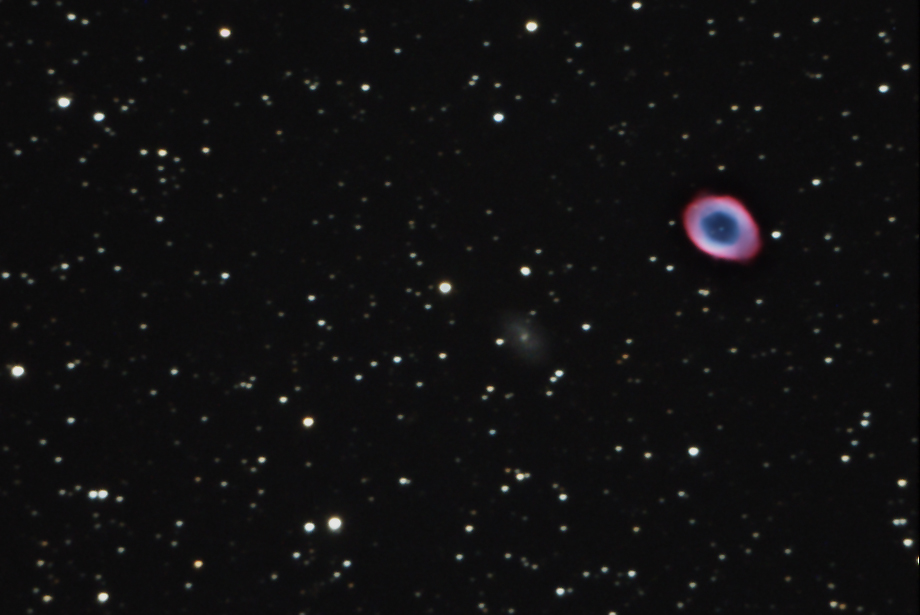 |
| NGC 3587 - The
Owl Nebula The Owl Nebula is a planetary nebula discovered by Pierre Mechain in 1791. A drawing in 1848 by William Parsons served to give it the name Owl Nebula. It is 2600 light years away and about 8000 years old. This was the first image I took with my new Celestron 9.25" f/10 cassegrain telescope. |
NGC 6960 - The
Veil Nebula Discovered by William Herschel in 1784, the Veil Nebula is a supernova remnant that formed about 15,000 years ago. Since it's so old it has expanded and dissapated enough that it no longer resembles a traditional looking planetary nebula. It is a nebula that has a number of brighter areas that astro photographers enjoy imaging. |
NGC 6960 - The
Veil Nebula This is another view of the Veil Nebula taken two weeks after the previous image. |
|
Location: Bonny Doon Airport, CA Date: March 9, 2013 Mount: AP 900GTo Telescope: Celestron 9.25"f/10 Cassegrain Camera: SBIG ST-4000xcm OSC Exposure: 18 x 5 min. subs = 1hr. 30min. |
Location: Cabrillo College Observatory, CA Date: September 15, 2010 Mount: Lomandy G11 Go-To Telescope: Orion 190mm f/5.3 Mak/Newt Camera: SBIG ST-4000xcm OSC @ -12c Exposure: 6 x 5 min. subs = 30min. |
Location: Cabrillo College Observatory, CA Date: September 29, 2010 Mount: Losmandy G11 Go-To Telescope: Orion 190mm f/5.3 Mak/Newt Camera: SBIG ST-4000xcm OSC @ -16c Exposure: 5 x 10 min. subs = 50min. |
 |
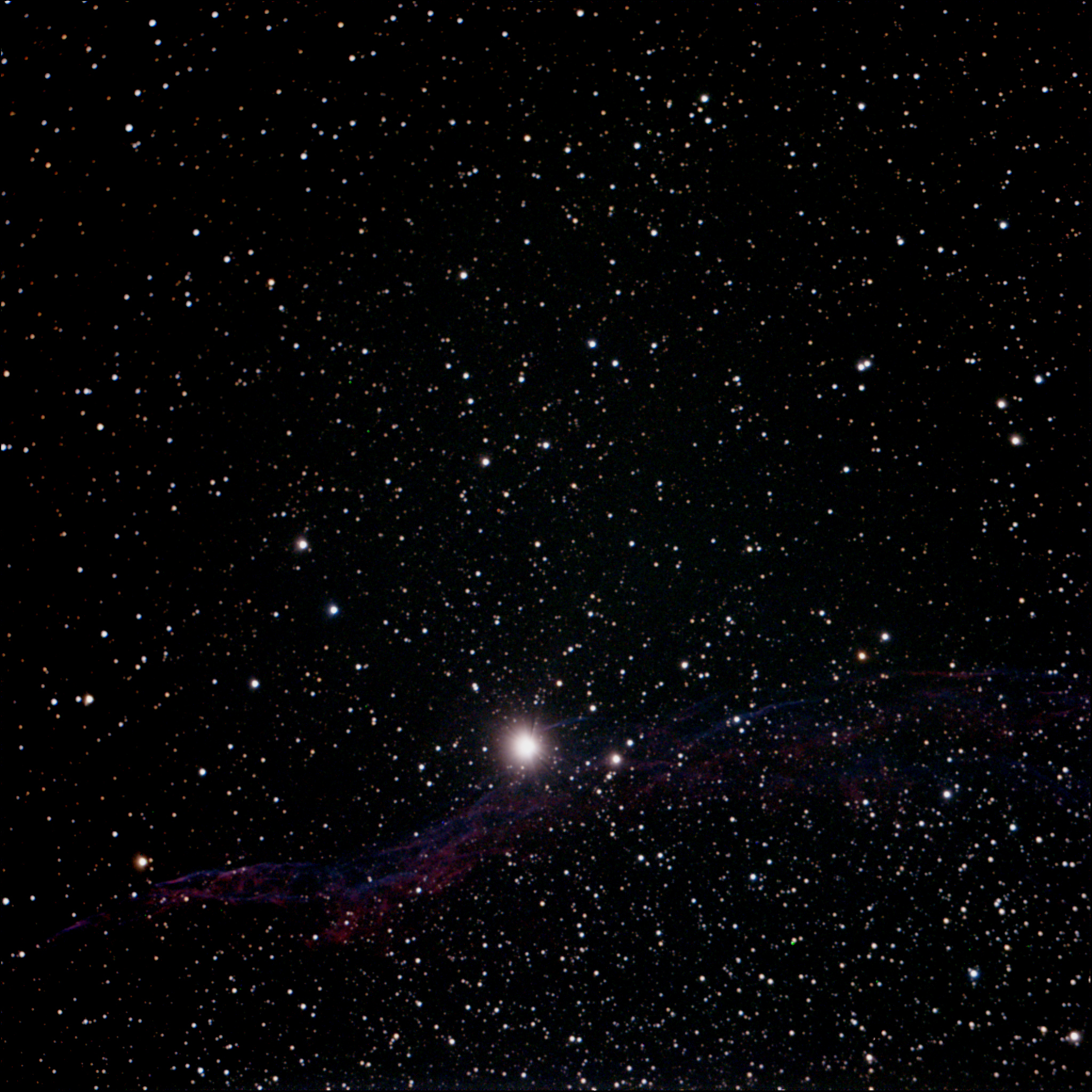 |
 |
| NGC 7293 - The
Helix Nebula The Helix Nebula is a planetary nebula that was discovered by Karl Ludwig Harding sometime before 1824. It is about 700 light years away. Its estimated age is around 11,000 years. |
NGC 2264 - The
Christmas Tree Cluster and H V.27 - The Cone
Nebula NGC 2264 is the bright area near the center known as the Christmas Tree Cluster. The Cone Nebula is in the upper right and is part of the star making nebular cloud that surrounds the central cluster. It is about 2600 light years away. |
NGC 7635 - The
Bubble Nebula The Bubble Nebula is an emission nebula that was discovered by William Herschel in 1787. It is about 7800 light years away. |
|
Location: Bonny Doon Airport, CA Date: September 6, 2010 Mount: Losmandy G11 GO-To Telescope: Orion 190mm f/5.3 Mak/Newt Camera: SBIG ST-4000xcm OSC @ -12c Exposure: 9 x 10 min. subs = 1hr. 30 min. |
Location: Bonny Doon Airport, CA Date: March 15, 2013 Mount: AP 900GTO Telescope: Orion 190mm f/5.3 Mak/Newt Camera: SBIG ST-4000xcm OSC @ -30c Exposure: 6 x 10 min. subs = 1hr. |
Location: Sun River, Bend, OR Date: July 24, 2011 Mount: Losmandy G11 Go-To Telescope: Orion 190mm f/5.3 Mak/Newt Camera: SBIG ST-4000xcm OSC @ -18 Exposure: 8 x 20 min. subs = 2hrs. 40min. |
 |
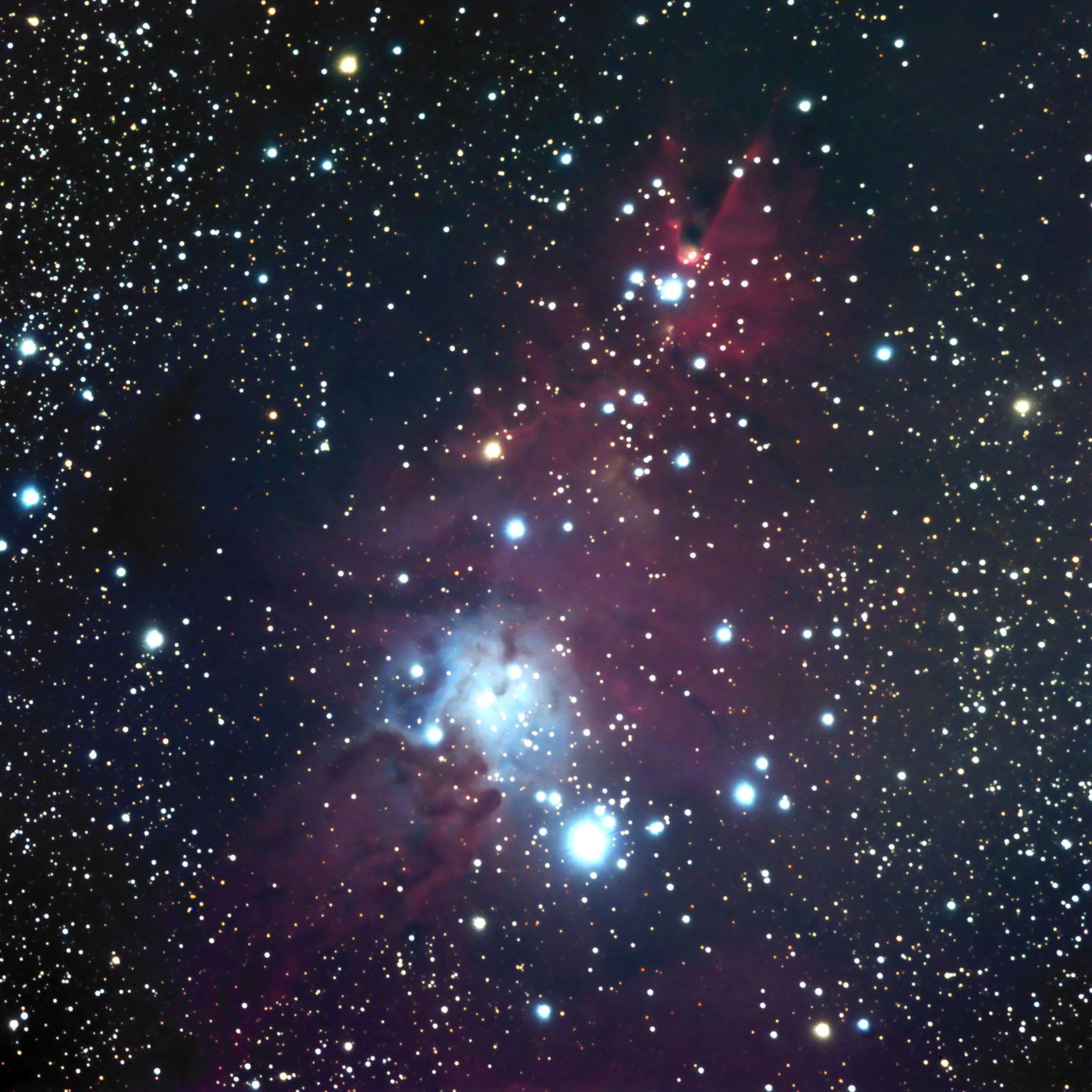 |
 |
| Messier 20 - The
Trifid Nebula This is one of my favorite images. The red portion is the more visible area and seems to be divided into three lobes, thus the name Trifid. The lower, red portion is an emission nebula. The upper, blue portion is a reflection nebula, and the dark areas that separate the sections are dark nebula. It is about 9000 light years away. |
Messier 27 - The
Dumbbell Nebula One of the more popular objects of visual astronomers and imagers alike, The Dumbbell Nebula is a planetary nebula located about 800 light years away. It was discovered by Charles Messier in 1764. |
NGC 1977 - The
Running Man Nebula The Running Man Nebula is another of my favorite images. It is a reflection nebula with a shape that looks like a running man, and is located just north of the Great Orion Nebula. This image has been flipped horizontally. |
|
Location: Golden State Star Party, Adin, CA Date: July 6, 2013 Mount: AP 900GTO Telescope: Celestron 9.25" f/10 Cassegrain Camera: SBIG ST-4000xcm OSC @ -18c Exposure: 20 x 10 min. subs = 3hrs. 20 min. |
Location: Golden State Star Party, Adin, CA Date: July 8, 2013 Mount: AP 900GTO Telescope: Celestron 9.25" f/10 Cassegrain Camera: SBIG ST-4000xcm OSC @ -18c Exposure: 26 x 10 min. subs = 4hrs. 20 min. |
Location: Bonny Doon Airport, CA Date: December 17, 2011 Mount: Losmandy G11 Go-To Telescope: Orion 190mm f/5.3 Mak/Newt Camera: SBIG ST-4000xcm OSC @ -24c Exposure: 14 x 5 min. subs = 1hr. 10 min. |
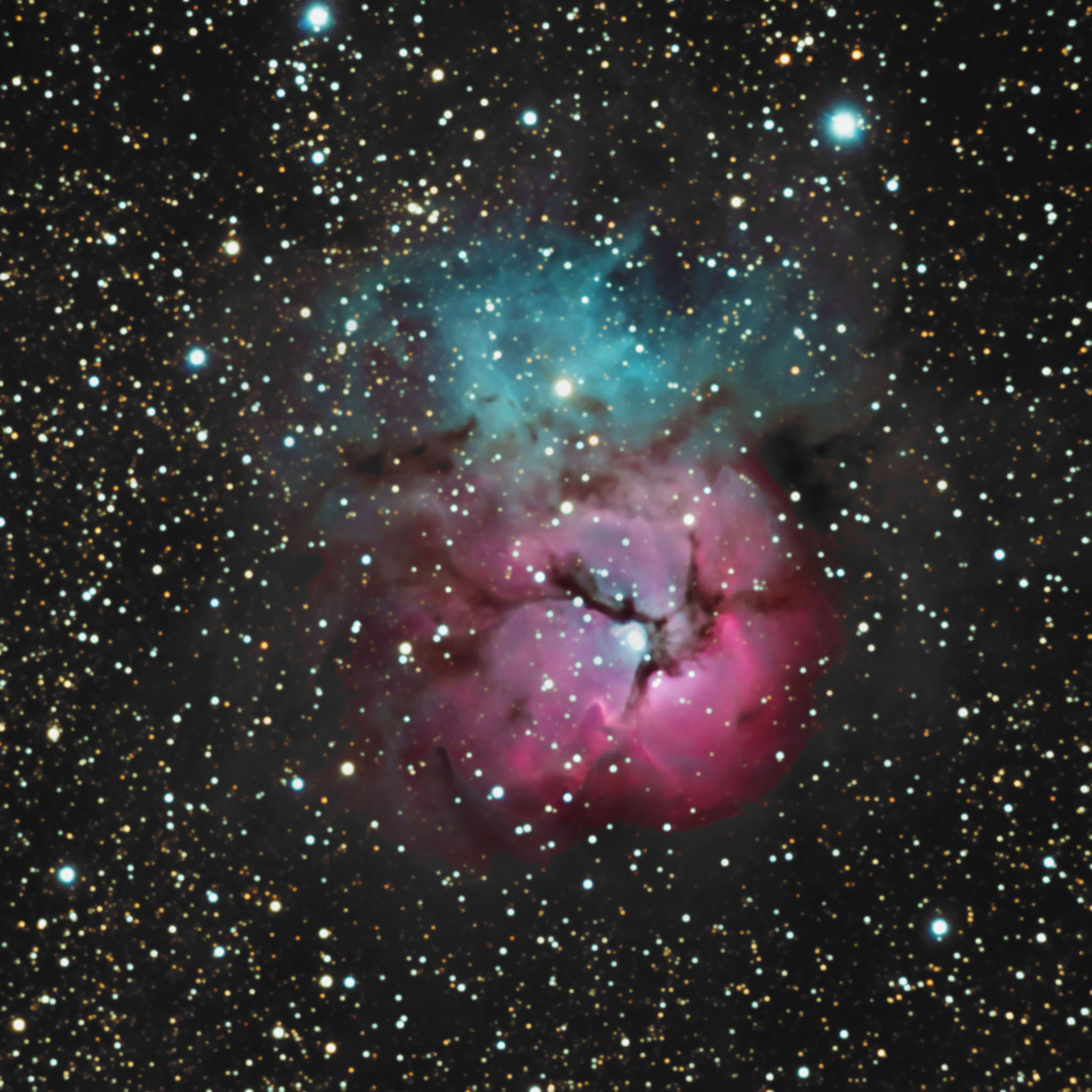 |
 |
 |
| Barmard 33 - The
Horsehead Nebula and NGC 2024 - The Flame Nebula The Horsehead Nebula is a dark nebula within the emission nebula IC 434 in the constellation Orion. It was first detected on a photographic plate by Williamina Fleming in 1888. It is nicely contrasted by the cloud of red hydrogen gas behind it. The bright star to the left of center is Alnitak. The bright area to the lower right of Alnitak is a star making region behind the dark nebula that is shining through from behind. The Flame Nebula to the bottom left is an emission nebula that lies about 1500 light years away. It is gas that is illuminated and excited by the star Alnitak above it. There are clouds of dark gas and dust in front of the nebula that gives it its flame appearance. |
Messier 42 - The
Great Orion Nebula The Orion Nebula is a diffuse nebula located about 1600 light years away and is about 24 light years across. The bright central region known as the Trapezium is an active star making area. This nebula is just part of a larger cloud of gas and dust that encompasses most of the constellation Orion. |
Messier 42 - The
Great Orion Nebula This is another image of the Great Orion Nebula. It was taken for practice out on the back deck. I had just purchased an SBIG AO-8 adaptive optics unit for improved guiding. |
|
Location: Bonny Doon Airport, CA Date: November 22, 2008 Mount: Losmandy GM-8 Telescope: Meade LDX-75 8" f/4 Camera: SBIG ST-4000xcm OSC @ -23c Exposure: 6 x 10 min. subs = 1hr. |
Location: Bonny Doon Airport, CA Date: November 22, 2008 Mount: Losmandy GM-8 Telescope: Meade LDX-75 8' f/4 Camera: SBIG ST-4000xcm OSC @ -23c Exposure: 4 x 5 min. subs = 20 min. |
Location: Watsonville, CA Date: March 2, 2012 Mount: Losmany G11 Go-To Telescope: Orion 190mm f/5.3 Mak/Newt Camera: SBIG ST-4000xcm OSC @ -28c Exposure: 10 x 5 min. subs = 50 min. |
 |
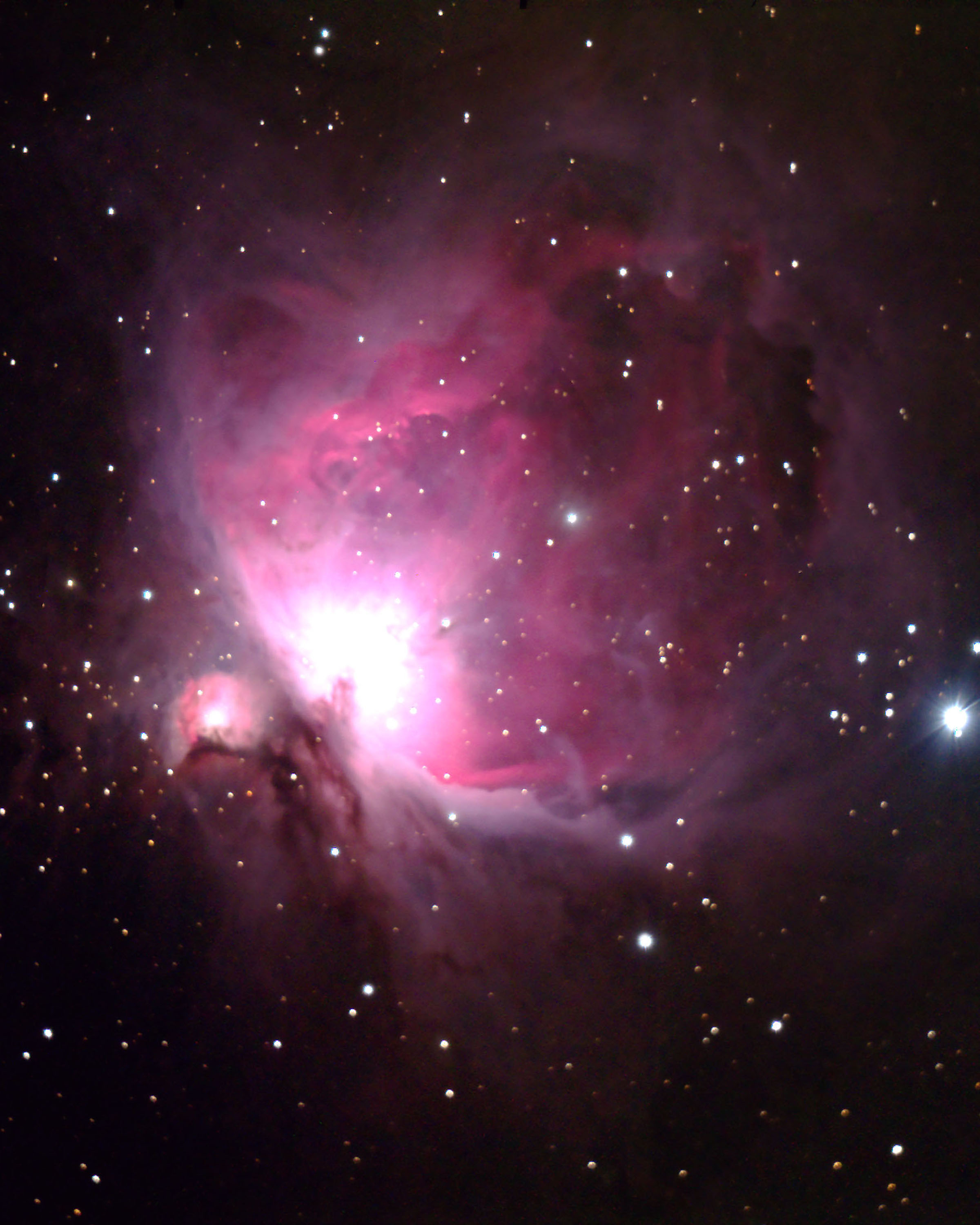 |
 |
| NGC 6888 - The
Crescent Nebula The Crescent Nebula is an emission nebula that lies about 5000 light years away. It was discovered by Friedrich Wilhelm Herschel in 1792. |
NGC 6888 - The
Crescent Nebula Here is another image of the Crescent Nebula taken two years after the one to the left. This was also imaged at the Nightfall Star Party at Borrego Springs, CA |
NGC 6995 - The
Veil Nebula East A section of the Eastern Veil Nebula. Taken at the Golden State Star Party. The Veil Nebula is a very feint cloud of hot gas that is a supernova remnant. It is estimated to be approximately 1500 light years distant. I combined 5 subs at -18c and 10 subs at -20c. |
|
Location: Borrego Springs, CA Date: October 28, 2011 Mount: Losmandy G11 Go-To Telescope: Orion 190mm f/5.3 Mak/Newt Camera: SBIG ST-4000xcm OSC @ -12c Exposure: 6 x 10 min. subs = 1hr. |
Location: Borrego Springs, CA Date: October 31, 2013 Mount: AP 900GTO Telescope: Celestron 9.25" f/10 Cassegrain w/6.2 FR Camera: SBIG ST-4000xcm OSC @ -20c Exposure: 22 x 10 min. subs = 3hr. 40 min. |
Location: Golden State Star Party, Adin, CA Date: June 28, 2014 Mount: AP 900GTO Telescope: Celestron 9.25" f/10 Cassegrain w/6.2 FR Camera: SBIG ST-4000xcm OSC @ -20c Exposure: 15 x 10 min. subs = 2hr. 30 min. |
 |
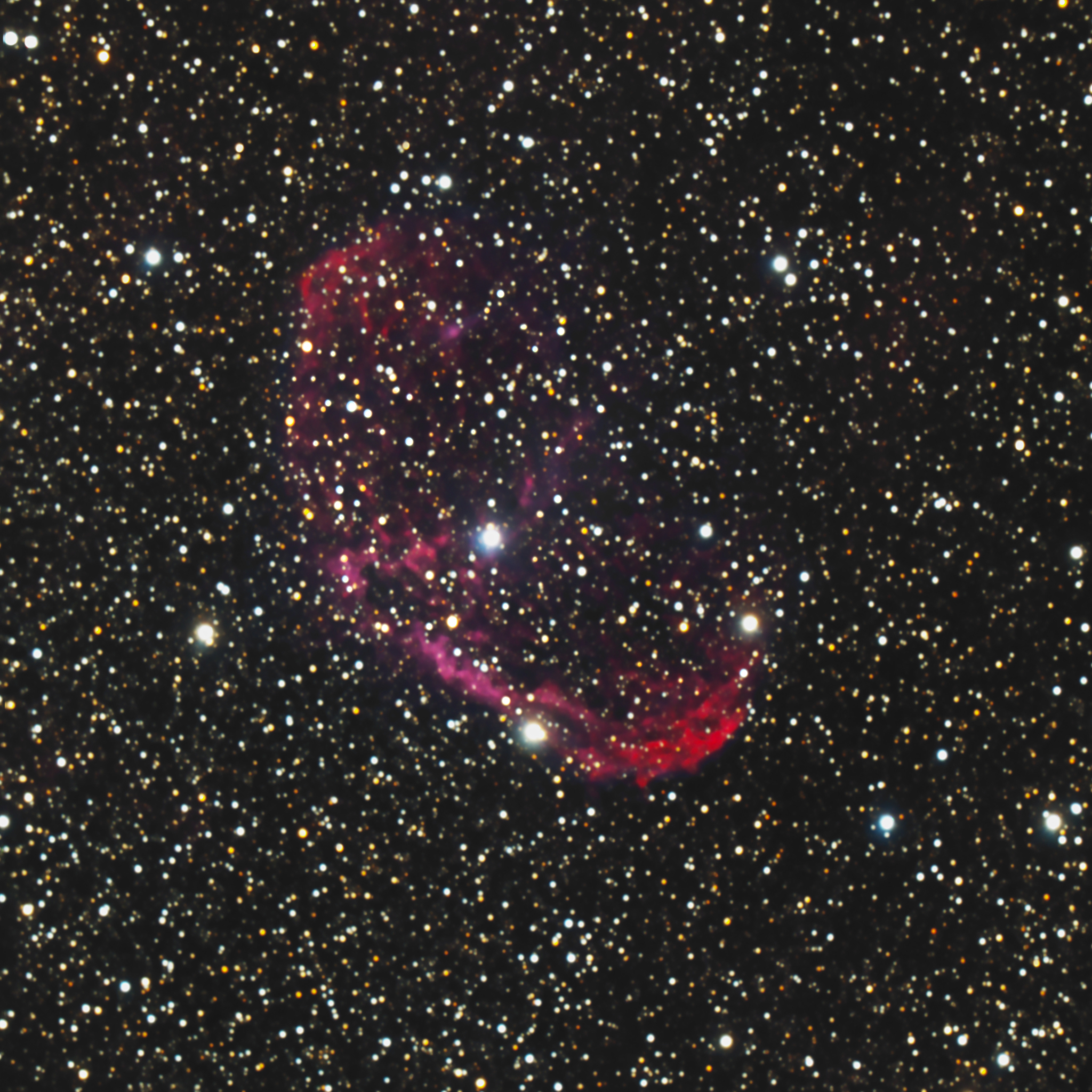 |
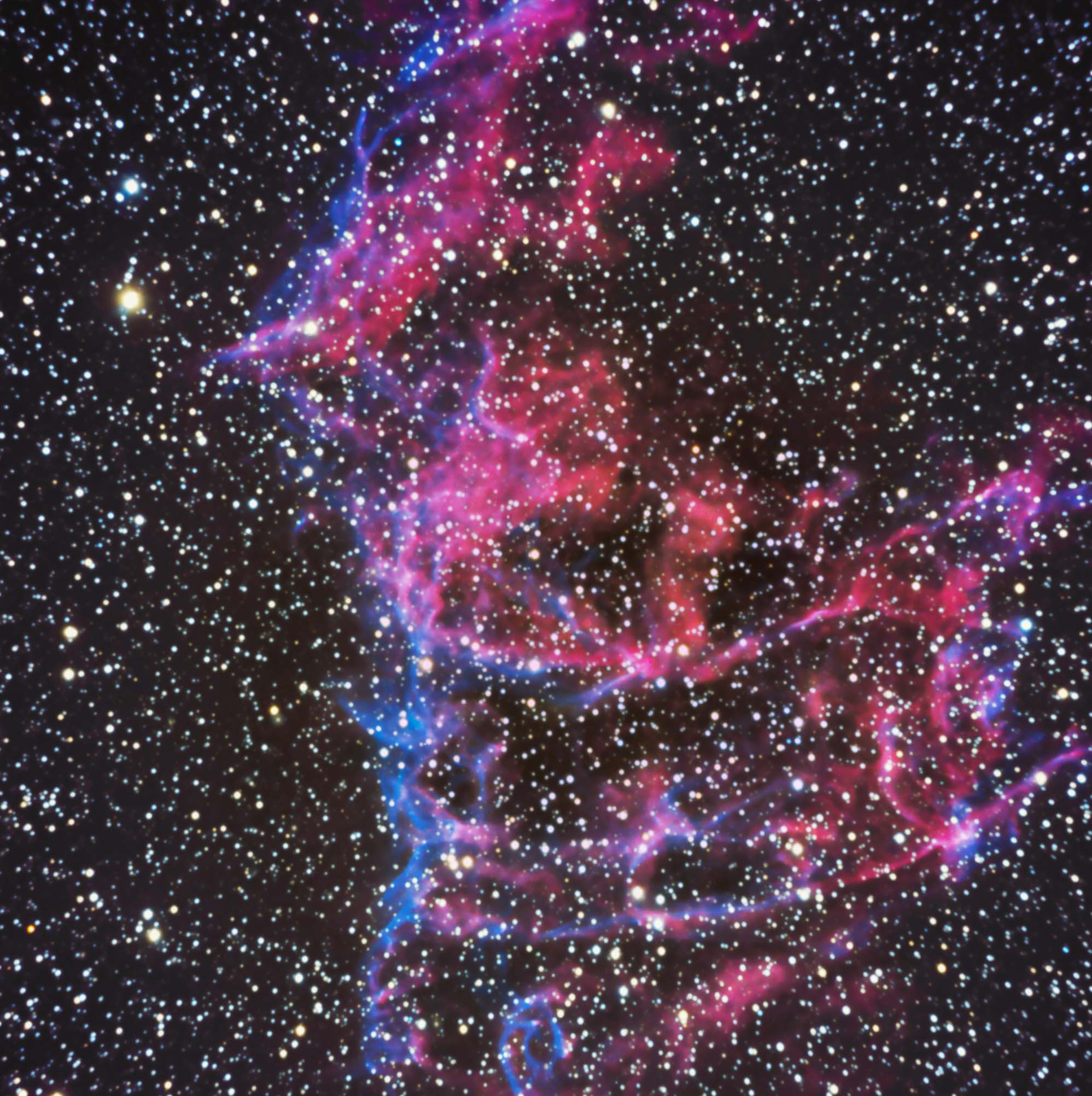 |
| NGC 6888 - The
Crescent Nebula Here is my first real attempt at imaging with my new SBIG STF-8300m camera with filters. This first image is 6 hours of color data. The other two to the right demonstrate how incorporating a Hydrogen Alpha image into a color image changes the end product. |
NGC 6888 - The
Crescent Nebula This second image is the Hydrogen Alpha. This was just one 30 minute image that was really noisy and took a lot of effort to get cleaned up. That's why we take as many images of an object as we can. |
NGC 6888 - The
Crescent Nebula Here are the color and Ha images combined. The Ha really brings a lot to the image and the new camera adds a tremendous amount of resolution. This is a vast improvement over the One-Shot-Color (OSC) camera. The trade-off is that it takes considerably longer to acquire all the sub frames for a finished image. |
|
Location: Golden State Star Party, Adin, CA Date: June 20, 2017 Mount: AP 900GTO Telescope: Celestron 9.25" f/10 Cassegrain Camera: SBIG STF-8300m w/filters @ -14c Exposure: R,G and B = 12 x 10 min. subs each = 6.0 hrs. |
Location: Golden State Star Party, Adin, CA Date: June 20, 2017 Mount: AP 900GTO Telescope: Celestron 9.25" f/10 Cassegrain Camera: SBIG STF-8300m w/filters @ -14c Exposure: Ha 1 x3 0 min. = 30min. |
Location: Golden State Star Party, Adin, CA Date: June 20, 2017 Mount: AP 900GTO Telescope: Celestron 9.25" f/10 Cassegrain Camera: SBIG STF-8300m with filters @ -14c Exposure: Combined Color and Ha = 6.5 hrs. |
 |
 |
 |
| Barnard 33 - The
Horsehead Nebula The Horsehead Nebula is a dark nebula located right next to the star Alnitak, which is the left-most star in Orion's belt. It is about 1200 light years away from us. More information is listed above with the wide-field view. This is the color version with a B&W version next door to the right. The nighttime temps. were pretty warm, so, even though I managed to get 4 hrs of exposure time there were considerable amounts of noise to deal with in processing. |
Barnard 33 - The
Horsehead Nebula This is the B&W version. Sometimes a color image that has some noise problems like the one to the left can be improved simply by converting to grayscale. Which do you like better? |
NGC 7635 - The
Bubble Nebula in Hydrogen Alpha This is a re-make of the Bubble Nebula - this time with my new camera, the SBIG STF-8300m with a Hydrogen Alpha filter. This is a one hour exposure. The next image is a combination of this image and an RGB image (Red, Blue, Green). The Bubble Nebula is an emission nebula that was discovered by William Herschel in 1787. It is about 7800 light years away. |
|
Location: Borrego Springs, CA Date: March 9, 2015 Mount: AP900 GTO Telescope: Celestron 9.25" f/10 Cassegrain/ Camera: SBIG ST-4000xcm OSC @ -12c Exposure: 24 x 10 min. subs = 4hr. |
Location: Borrego Springs, CA Date: March 9, 2015 Mount: AP900 GTO Telescope: Celestron 9.25" f/10 Cassegrain Camera: SBIG ST-4000xcm OSC @ -12c Exposure: 24 x 10 min. subs = 4hr. |
Location: Borrego Springs, CA Date: October 17, 2017 Mount: AP900 GTO Telescope: Celestron 9.25" f/10 Cassegrain Camera: SBIG STF-8300m @ -14c Exposure: 2 x 30 min. subs = 1hr. |
 |
 |
 |
| NGC 7635 - The
Bubble Nebula (RGB + Ha) This is a combination of the preceeding Hydrogen Alpha image with an RGB image. I was only able to get 30 minutes of exposure time on this object due to operator error with my guide scope. Will do better next time. |
|
|
Location: Borrego Springs, CA Date: October 17, 2017 Mount: AP900 GTO Telescope: Celestron 9.25" f/10 Cassegrain Camera: SBIG STF-8300m @ -14c Exposure: 3 x10 min. subs = 30 min. |
Location: Date: Mount: Telescope: Camera: Exposure: |
Location:
Date: Mount: Telescope: Camera: Exposure: |
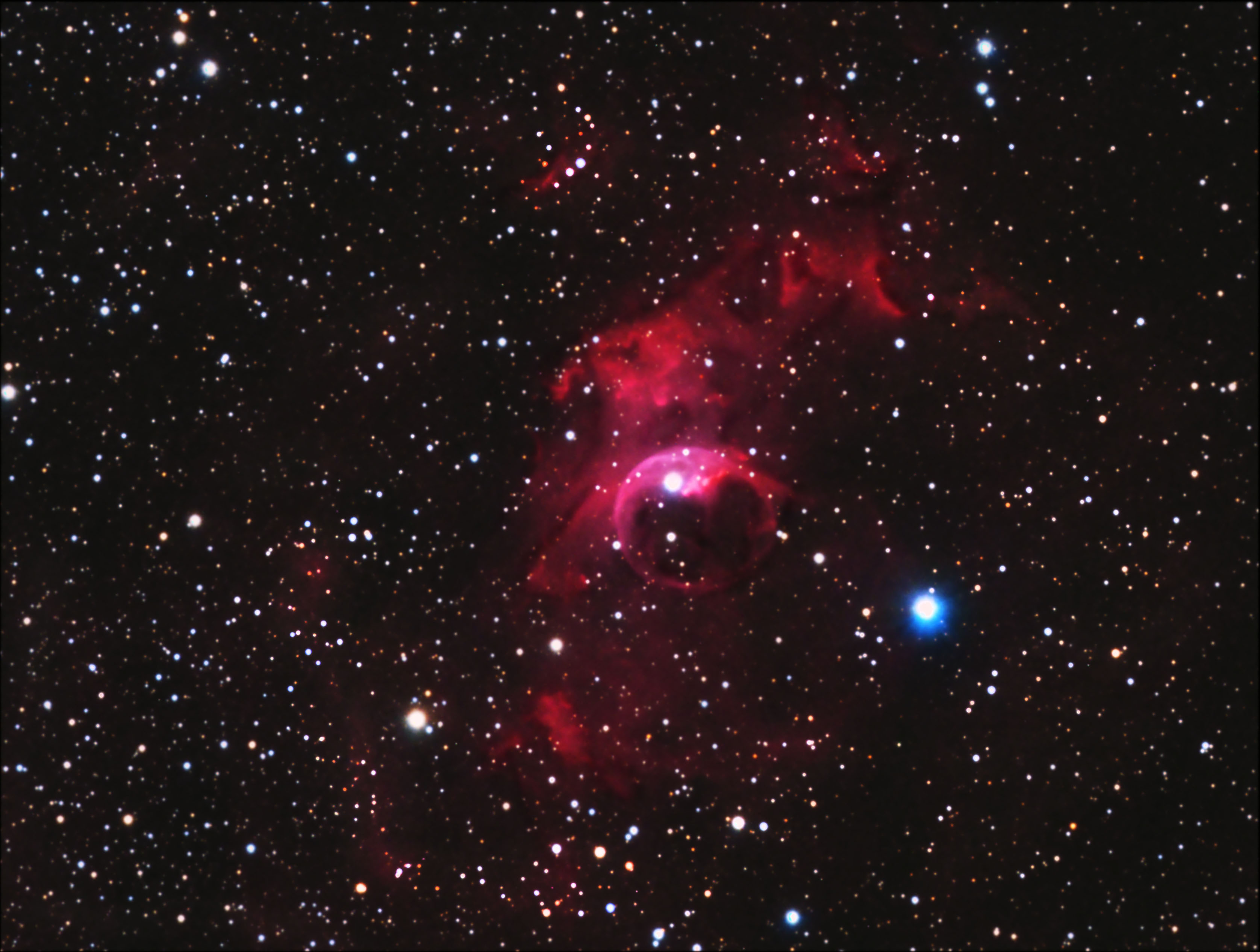 |
Except as noted all images Copyright © by Ron Yelton and may not be used without permission.